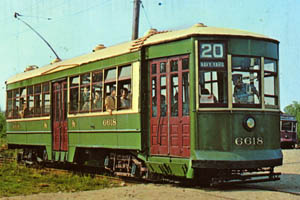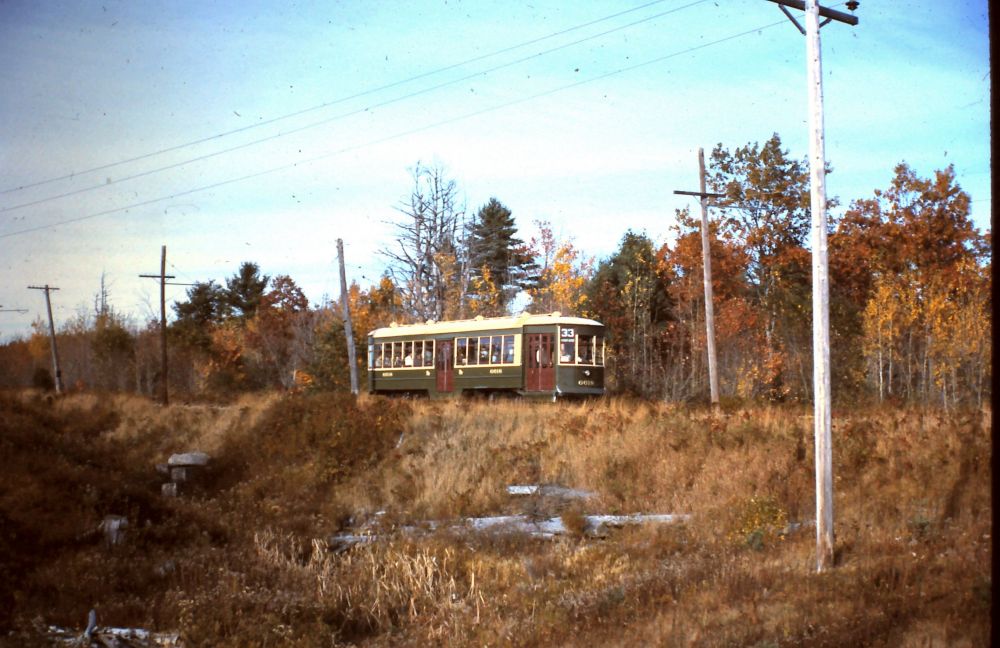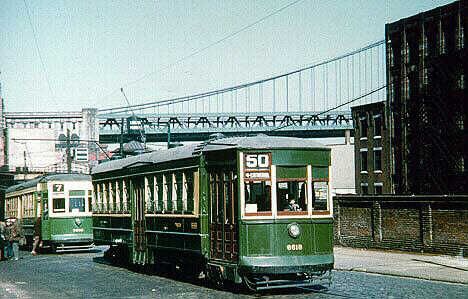
- Builder
- J. G. Brill Co.
- Description
- Peter Witt, converted from Nearside
- Secondary Use
- None
- Type
- City and Suburban Streetcars
- Year
- 1912
- Retired from Service
- 1954
- Acquired by the Museum
- 1955
- Note
- As of April 2017, No. 6618 was stored at Fairview. The car lacks windows.
- Fund
- 804
Philadelphia Rapid Transit Co. 6618
From Philadelphia, Pennsylvania
History
The Philadelphia Rapid Transit Co., which had taken over a group of underlying properties, was faced with a collection of small, inefficient streetcars, which were aging rapidly and mechanically worn out. PRT turned to the local carbuilder, J. G. Brill, and ordered 1,500 identical cars in 1911-1913 to replace most of its fleet. No. 6618 was part of this order. This is believed to be the largest single group of standardized streetcars ever acquired by any transit property anywhere in the world. These cars were dubbed “Nearside” cars, since they loaded at the frond door before crossing the intersection, rather than crossing to the far side and loading from the rear. The conductor sat behind the motorman, and collected fares as people entered. The cars had a small emergency door at the rear, but exiting passengers used the front door which interfered with those boarding. PRT immediately recognized the problem and responded by replacing the emergency doors with large center doors on 1,160 of the “Nearside” cars. In doing so, the company moved the conductor’s position to just forward of the center door, making the cars conform to the Peter Witt fare collection system. In the 1930s, PRT scrapped the 340 “Nearsides” without center doors. PRT later converted most of the surviving cars to one-man operation.
In 1940, PRT reorganized as the Philadelphia Transportation Company. The “Nearsides” persisted into the 1950s, being retired only when buses replaced them. One car, No. 6618, was one of few cars not converted to one-man operation. Instead, in the early 1940s, PTC converted No. 6618 into an instruction car, where the instructor could challenge the operator with various obstacles including no air, slippery rail, and “Oscar”, a dummy tossed in front of the car. The car included a specially-built control panel for the instructor behind the front platform.
As the “Nearsides” dwindled in number, the instruction car became surplus, and Seashore chose it for preservation. Philadelphia Transportation Company donated No. 6618 to Seashore in 1955. Seashore contemplated continuing to use No. 6618 as an instruction car for museum operators. Seashore rebuilt the trucks from Philadelphia’s 5 ft. 2 ¼ in. track gauge to standard gauge (4 ft. 8 1/2 in.). Seashore repainted the car and began to fix a leaky roof and sagging platform. This turned into a bigger project than was expected. Work on No. 6618 was been suspended awaiting additional funding is available. In 1975, PTC successor, Southeastern Pennsylvania Transportation Authority, proposed to pay for restoration of No. 6618 and to lease the car for operation as part of the national bi-centennial. However, the museum’s trustees decided against sending the car to Philadelphia. No. 6618 is the only survivor of Philadelphia’s “Nearside” cars.
Technical Information
- Seats: 51
- Control: K-36J
- Brakes: Straight Air
- Compressor: CP-27
Trucks
- Number: 2
- Manufacturer: Brill
- Model: 39E
Motor
- Number: 2
- Manufacturer: General Electric
- Model: 201F
Weight and Dimensions
- Length: 45’ 6.00"
- Width: 8’ 6.00"
- Height: 12’ 1.00"
- Weight: 36000 lbs.
Additional Images

Russell Monroe in Oct. 1962

Bill Volkmer Collection at newdavesrailpix.com
© 1998 - 2025 New England Electric Railway Historical Society. All Rights Reserved.